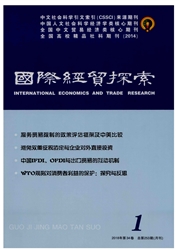

 中文摘要:
中文摘要:
韩国51年来经济增长和成功跨越中等收入陷阱的经验将为中国提供重要借鉴和启示。在总结现有文献和数量分析的基础上识别了韩国两个不同阶段的增长故事:经济增长期(1961—1990年)和经济转型期(1991—2011年)。随后利用SFA模型分解了生产要素的增长贡献,对以上两个阶段的比较表明:“内涵式增长”是51年来韩国经济增长的主要方式,在经济增长阶段,韩国人尤其注重经济运行效率的提高:特定的历史情境下国际背景和国内条件综合决定了韩国内涵式经济增长路径:资本密集型产业主导经济增长时期,资本投入的增加导致了全要素生产率水平的降低和经济运行效率的迅速下降:世界分工程度的趋缓和国际市场的逐渐饱和推动韩国经济进入转型期,此前对经济运行效率的强调转移至技术进步。由此给出了对中国经济增长和转型的相关启示.
 英文摘要:
英文摘要:
South Korea's 51 years of economic growth and success across the middle- income trap experience will provide an important reference and inspiration for China. Based on the conclusion of existing literature and quantitative analysis about South Korea, the paper identifies two different stages of economic growth story: one is economic growth stage, and the other is economic transformation stage. Then it uses SFA model to decompose the factors contributing to the economic growth, and compares the above two phases. The result shows that: (1) "organic growth" is the main form of Korea's economic growth in the past 51 years, and they focus on economic efficiency in the phases of economic growth; ( 2 ) the international and domestic conditions in the specific historical background and context together determine Korea's path of economic growth; (3) when capital-intensive industries dominate economic growth, the increase of capital investment has led to a lower level of total factor productivity and a rapid decline of economic efficiency; (4) the slowdown of the world labor division degree and the gradual saturation of international markets have promoted the Korean economy into the transition period, in which their emphasis on economic efficiency has transferred to technical progress. Finally, it proposes implications for China's economy growth and transformation.
 同期刊论文项目
同期刊论文项目
 同项目期刊论文
同项目期刊论文
 期刊信息
期刊信息
